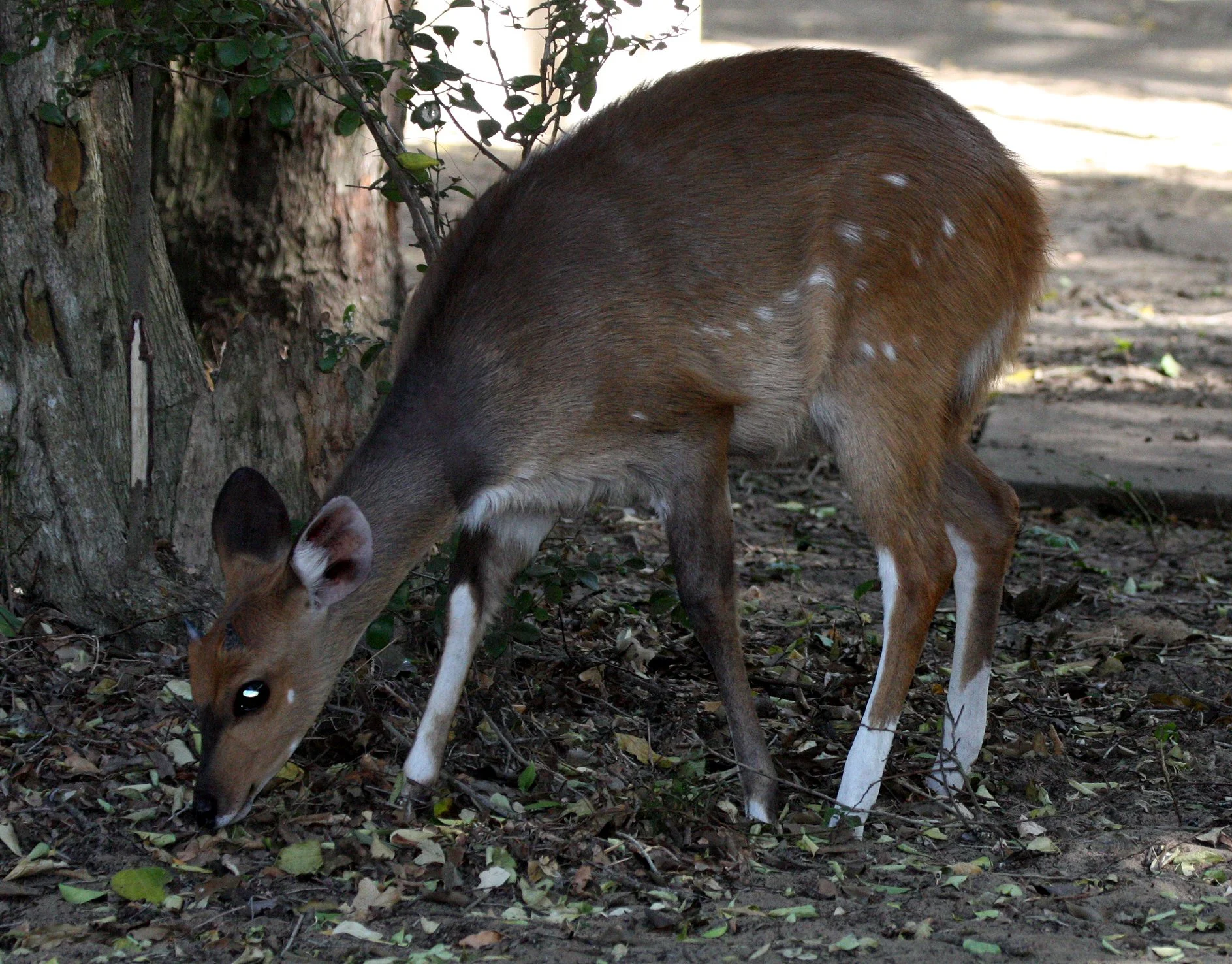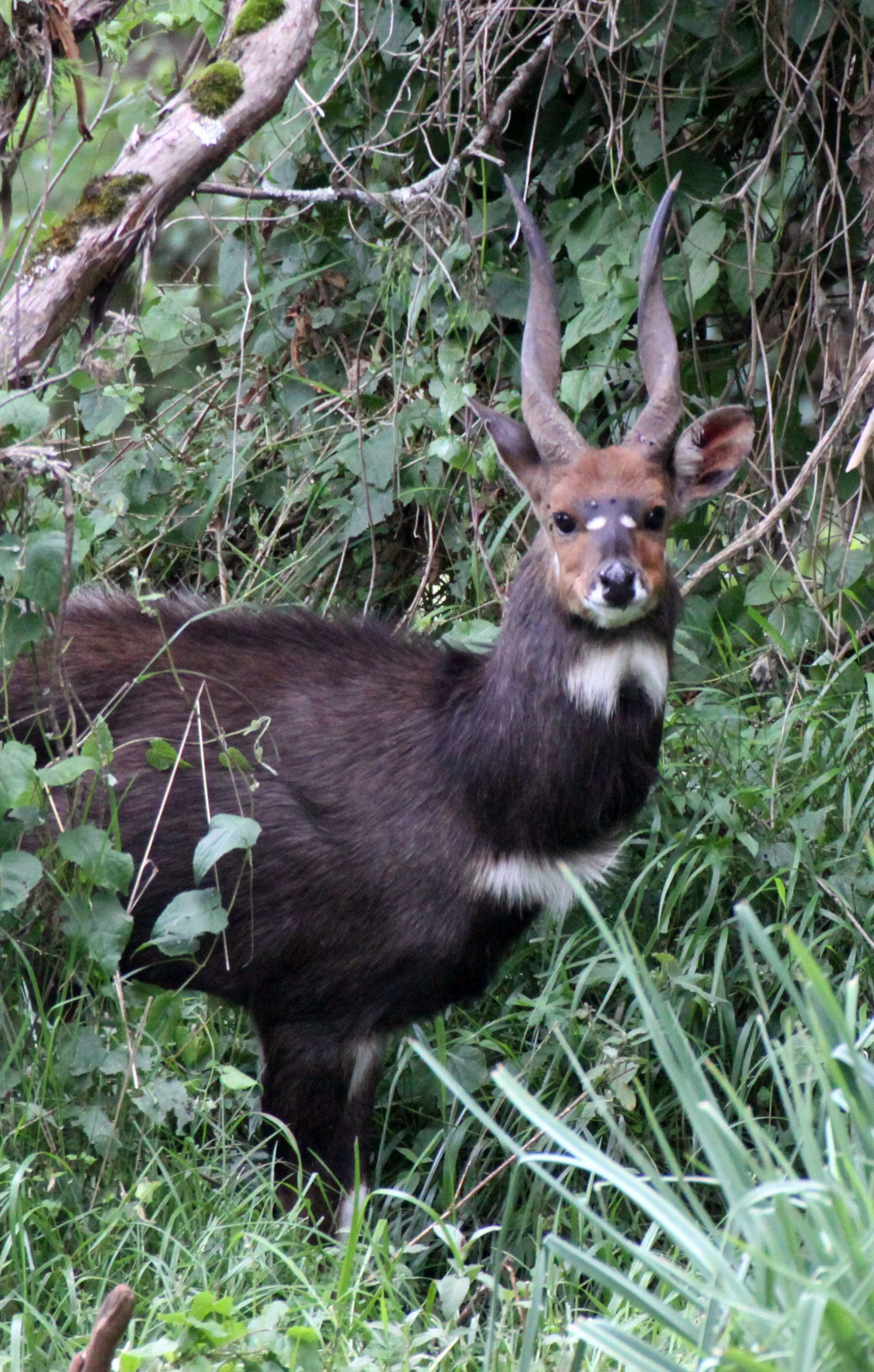
The bushbuck (Tragelaphus scriptus) is a common and a widespread species of antelope in Sub-Saharan Africa. Bushbuck are found in a wide range of habitats, such as rain forests, montane forests, forest-savanna mosaic, savanna, bushveld and woodland.[3] Bushbuck stand about 90 centimetres (35 in) at the shoulder and weigh from 45 to 80 kilograms (99 to 176 lb). They are generally solitary, territorial browsers.
Bushbuck have been fractured into over 40 subspecies in the past. mtDNA profiles of a large amount of samples were resolved in 2009 as belonging to nineteen groups, some corresponding to previously described subspecies, others were previously unrecognised and remained unnamed. The nineteen groups were then organised into two taxa: a nominate northern subspecies (Tragelaphus scriptus scriptus) and a southern subspecies T. scriptus sylvaticus. In the 1780 original description of sylvaticus from the Cape Region by Sparrman, there is no mention made of striping. According to Moodley et al., males of type populations in West Africa are more often striped than southern and eastern specimens, although this is not always the case.
In 2011, on the other hand, Groves and Grubb advocated recognising the bushbuck population as eight species: Tragelaphus scriptus (Pallas, 1766); T. phaleratus (Hamilton Smith, 1827); T. bor Heuglin, 1877; T. decula (Rüppell, 1835); T. meneliki Neumann, 1902; T. fasciatus Pocock, 1900; T. ornatus Pocock, 1900; and T. sylvaticus (Sparrman, 1780), grouped in a northern and southern 'group'. The Ethiopian endemic species known as Menelik's Bushbuck or decula was classified as a scriptus group species as opposed to Woodley. In the case of Tragelaphus, these 'species' would be based mostly on geography and pelage as opposed to genetics.[4] These proposals are controversial.
In this gallery:
Menelik’s Bushbuck (Tragelaphus meneliki)
Cape Bushbuck (Tragelaphus sylvaticus)
Nile Bushbuck (Tragelaphus bor)
The Cape bushbuck (Tragelaphus sylvaticus) is a common and a widespread species of antelope in Sub-Saharan Africa.[2][3] Bushbuck are found in a wide range of habitats, such as rain forests, montane forests, forest-savanna mosaic, savanna, bushveld and woodland.[3] Bushbuck stand about 90 centimetres (35 in) at the shoulder and weigh from 45 to 80 kilograms (99 to 176 lb). They are generally solitary, territorial browsers.
The taxonomy of bushbuck, and of the Tragelaphini tribe in general, has been contested. Bushbuck have been fractured into over 40 subspecies in the past. mtDNA profiles of a large amount of samples were resolved in 2009 as belonging to nineteen groups, some corresponding to previously described subspecies, others were previously unrecognised and remained unnamed. The nineteen groups were then organised into two taxa: a nominate northern subspecies (Tragelaphus scriptus scriptus) and a southern subspecies T. scriptus sylvaticus. In the 1780 original description of sylvaticus from the Cape Region by Sparrman, there is no mention made of striping. According to Moodley et al., males of type populations in West Africa are more often striped than southern and eastern specimens, although this is not always the case.
In 2011, Groves and Grubb advocated recognising eight species of bushbuck: Tragelaphus scriptus (Pallas, 1766); T. phaleratus (Hamilton Smith, 1827); T. bor Heuglin, 1877; T. decula (Rüppell, 1835); T. meneliki Neumann, 1902; T. fasciatus Pocock, 1900; T. ornatus Pocock, 1900; and T. sylvaticus (Sparrman, 1780), grouped in a northern and southern 'group'. The Ethiopian endemic species known as Menelik's Bushbuck or decula was classified as a scriptus group species as opposed to Woodley. In the case of Tragelaphus, these 'species' would be based mostly on geography and pelage as opposed to genetics. These proposals are controversial.
In 2018, Hassanin et al. published a molecular phylogenetic study that provided support for the scriptus and sylvaticus clades, with a divergence time of at least 2 million years, albeit with considerable genetic diversity within each of these groups.
Bushbuck stand about 90 centimetres (35 in) at the shoulder and weigh from 45 to 80 kilograms (99 to 176 lb) (depending on sex). They have a light brown coat, with up to seven white stripes and white splotches on the sides. The white patches are usually geometrically shaped and on the most mobile parts of their body, such as the ears, chin, tail, legs and neck. The muzzle is also white. Horns, found only on the males, can reach over half a metre and have a single twist. At 10 months old, young males sprout horns that are particularly twisted and at maturity form the first loop of a spiral.
The Cape bushbuck has on average less striping and more uniform colouration than populations in West Africa. Cape bushbuck occur from the Cape in South Africa to Angola and Zambia and up the eastern part of Africa to Ethiopia and Somalia, according to one interpretation. Other interpretations restrict the taxon to Southern Africa sensu stricto or consider them sensu lato to occur in the above range except eastern Sudan, Ethiopia and Somalia
Cape Bushbuck (Tragelaphus sylvaticus) seen in many locations in southern Africa and central Africa.








































Nile Bushbuck (Tragelaphus bor) - Aberderes National Park Kenya














Menelik’s Bushbuck (Tragelaphus meneliki) - Ethiopia Endemic




































































